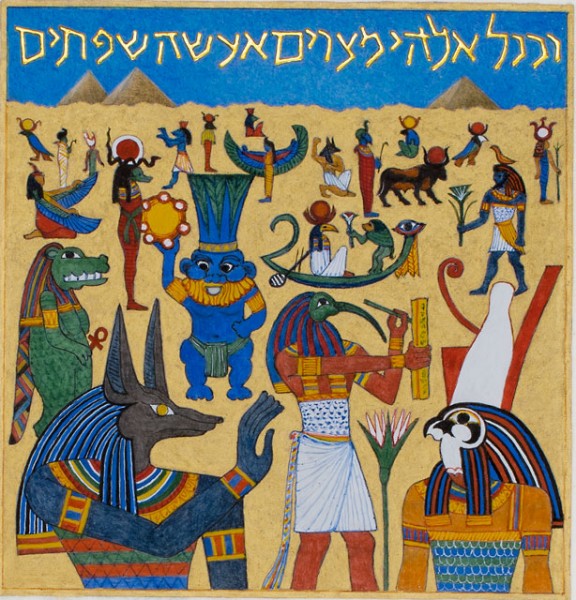
Barbara Wolff, “The Rose Haggadah,” detail, p. 19, illuminated manuscript, 2011-13 (artwork © 2014 Barbara Wolff / digital photography by Rudi Wolff)
Morgan Library & Museum
225 Madison Ave. at 36th St.
Tuesday – Sunday through May 3, $12-$18 (free Fridays 7:00 to 9:00)
212-685-0008
www.themorgan.org
www.artofbarbarawolff.com
Passover doesn’t begin until April 3, but you can get a head start on the holiday, in which Jews around the world retell the story of the exodus from Egypt, by visiting the Morgan Library and checking out its lovely exhibition “Hebrew Illumination for Our Time: The Art of Barbara Wolff,” comprising the first two illuminated Hebrew texts to join the Morgan’s celebrated collection of illuminated manuscripts, as well as its very first Haggadah. In 2011, New York artist Barbara Wolff was commissioned by the Rose family to create an illuminated Haggadah, the book used at the Passover seder that contains prayers, hymns, historical tales, biblical scenes, and other elements that expand upon the Jews’ enslavement and their battle with the Pharaoh more than three thousand years ago. Working with her unique blend of silver, gold, and platinum foils on vellum, Wolff designed beautiful artwork to accompany Izzy Pludwinski’s Ashkenazic Hebrew calligraphy and Karen Gorst’s English captions, incorporating flora and fauna native to the Middle East along with the standard elements of the Passover seder, including such symbolic food as the Paschal lamb, matzah, and bitter herbs. Each page is exquisitely designed: A large eye oversees a pyramid in which slaves are shown hard at work, more than twenty colorful ancient Egyptian gods are gathered together in the desert, and the ten plagues are depicted above and below a lush gold area featuring silver Kiddush cups spilling drops of red wine. The Rose Haggadah is a far cry from the familiar, old-fashioned blue-and-white Maxwell House Haggadah that was so prevalent throughout much of the twentieth century. Wolff’s remarkable sixty-four-page book honors Jewish tradition in a format more associated with Christianity, bringing new life to an annual ritual that honors the past while projecting hope for the future.

Barbara Wolff, “Among the Branches They Sing” from “You Renew the Face of the Earth: Psalm 104,” illuminated manuscript, MS M.1190, fol. 3 (artwork © 2015 Barbara Wolff / photography by Rudi Wolff)
The exhibit also includes Wolff’s illuminated version of Psalm 104, “You Renew the Face of the Earth,” ten elegant works in which she uses platinum, silver, and gold leaf on goatskin parchment. “This great hymn to the divine in nature directs our awareness to the miracle of the world,” Wolff writes in the free exhibition handout. “The sentiments expressed in this psalm have particular relevance for our own era, a time of growing consciousness of the profound effect of human enterprise on nature, and of questioning our role as steward of our planet.” The ten illuminations include the signs of the zodiac, which represent the twelve tribes of Israel; golden Hokusai-like waves above rising mountains; a silver leviathan encapsulating smaller sea creatures; and twenty-eight Israeli birds in and around a Tabor oak, with every animal specifically identified. Wolff adds commentary about each folio; for example, in “To Bring Forth Bread,” which shows grains growing, she writes, “Wild grass, ancestor of man’s most ancient cultivated crop, became the foundation of civilization. . . . Shining fields of wheat and filled granaries are symbols of security, peace, and plenty.” The exhibition is supplemented by illuminated manuscripts from the Morgan’s collection that influenced Wolff, as well as a twenty-two-minute film that highlights her intricate, intensely dedicated working process. In conjunction with the exhibition, Vassar professor Marc Michael Epstein will deliver the talk “Skies of Parchment, Seas of Ink: Barbara Wolff and her Place in the History of Jewish Manuscript Illumination” on April 1 at 6:30; on April 12 at 2:00, Wolff will lead the workshop “The Midas Touch”; on April 15 at 7:00, composer and accordionist Merima Ključo, artist Bart Woodstrup, and pianist Seth Knopp will team up for the multimedia presentation “The Sarajevo Haggadah: Music of the Book”; and on April 18 at 2:00, Stephanie Krauss will lead the workshop “My Very Own Illuminated Manuscript — Part 2: Putting It Together” for children eight and older.